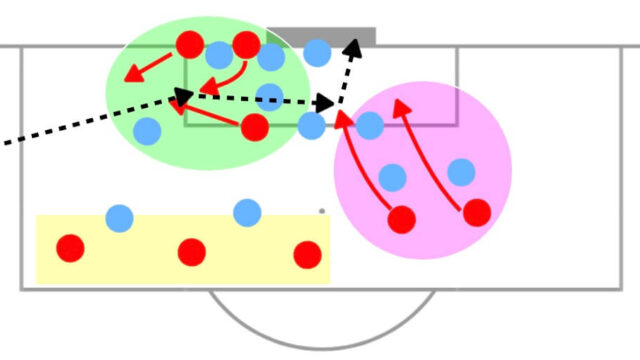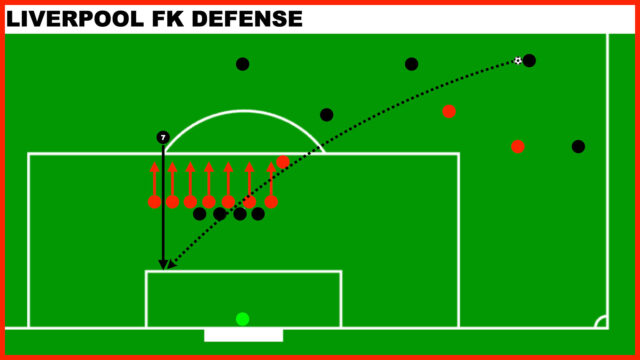In this article, Arsenal’s attacking corner kick tactics are going to be analysed in detail.
Overview
The main takers are Declan Rice, Bukayo Saka and Noni Madueke. Most corner kicks were in-swinging deliveries and Rice is the only player who has delivered out-swinging corners in the league, which were mostly against Liverpool at Anfield.
The important key factors to understand Arsenal’s corner kick tactics are their unique starting positions, overloads at either of the first post or back post and how they make the most of Gabriel Magalhães. Thus, in this article, these points are going to be analysed along with their use of short corner routines.

Starting Positions
How Nicolas Jover, the set piece coach positions the players inside and around the box had been quite interesting, and even there are a few evolutions this season. The first one to discuss is packing the players around the back post area, which is the blind side of most opposition players.
This is the example that Christian Nørgaard pulled one back against Villarreal in the preseason game.

As the illustration shows, Arsenal’s attackers inside the box initially stayed at the far side and made runs to come inside the 6-yard box or block the opposition furthest zonal defenders to let Nørgaard (No.16) free. And it was successful as he could effortlessly head the ball into the goal even without leaving the ground.

Another unique and latest setup was performed in the opening game of the Premier League, and from the first corner, they could find the opener. It was the first and only goal in the game against Manchester United.
This time, there were five players at the edge of the box and only four players inside the box before the ball was delivered.

From these starting positions, Gabriel Martinelli (No.11) and Martín Zubimendi (No.36) made runs towards the goal while Ben White (No.4) stepped back to get ready for the opposition counterattack just in case. And both Martin Ødegaard (No.8) and Bukayo Saka (No.7) stayed at the edge of the box, as usual.
Eventually, the delivery towards the goal wasn’t dealt with well by Man United’s goalkeeper and Riccardo Calafiori (No.33) headed it into the goal.

So far, Arsenal’s attacking setups against only zonal or mix defending were discussed. So, how do they position themselves against man marking organisations? The example below shows their setup against Athletic Club in the Champions League.

Against man oriented defending, the players spread inside the box to stretch the opposition structure. Then, two players at the far side made horizontal runs towards the first post area in front of the opposition two zonal defenders. In addition to them, Cristhian Mosquera (No.3) also moved around the opposition goalkeeper and appeared at the first post area. These runs created space at the back post for Gabriel and Mikel Merino (No.23) to attack by drifting from the middle.

Jover tries to isolate each 1v1. By spreading the players inside the box, they can use bigger space and make more dynamic movements. This is helpful to open space intentionally or make the most of individual superiority. This idea is also a key to maximising Gabriel’s ability, which will be discussed later.
Overload
From each starting position, the players make designed runs and they often create an overload at the far side or near side. The example below shows how they moved from the starting position of packing the far side against Leeds.

Against the opposition zonal structure, four players initially stayed in their blind side and showed up at the near post area. Additionally, the isolated attacker, Gabriel also attacked the space in front of the first post by beating his marker.

This overload enabled to left Jurrien Timber (No.12) unmarked and let him head the ball in between the zonal defenders to open the scoring. As it is illustrated, Arsenal had more players than Leeds in the area, meaning Arsenal’s probability of getting the first contact was higher. Not that simple, though.
Another one is in the game against Newcastle that Gabriel scored the match-winner. Newcastle defended with three zonal defenders inside the 6-yard box and had five man marking defenders. Therefore, their starting position was to spread the attackers.

From each position, William Saliba (No.2) and Viktor Gyökeres (No.14) played important roles which were to block the opposition goalkeeper and zonal defender respectively. Then, Gabriel and Merino, who were the main targets on many occasions, plus Timber made runs around the near side.

Thanks to Saliba’s block against the goalkeeper, the ball was successfully delivered to Gabriel and he strongly headed the ball into the net.
The last one is to create an overload at the back post. Similarly to the previous examples, from their starting positions, they made designed runs to block the opponents and attack the space. This time, against Burnley.

The initial setup is similar to the one against Leeds, but the players only moved to the middle. Again, Saliba and Gyökeres blocked the zonal defender in the middle and Timber also blocked the zonal defender in front of the back post to create space behind him.

Calafiori and Gabriel moved to the space at the far side and Gabriel successfully played the ball back to the middle and Gyökeres headed it in just in front of the goal.
They have a clear plan and communication on the pitch, so they all share where the next corner will be delivered. That’s why they can overload a certain area and why Gabriel is always there.
Gabriel Magalhães
As you notice, the ball is always delivered to where Gabriel is. He is the strongest defender in open play, but the most dangerous attacker in set pieces. Some of the examples were already shared, but two more of his assists will be analysed here.
The first one was against Fulham, which Leandro Trossard (No.19) scored the only goal in the game.

Fulham defended on the basis of the zonal structure and two defenders were marking Gabriel. However, he quickly and strongly ran through them to attack the ball at the near side and flick it to Trossard.
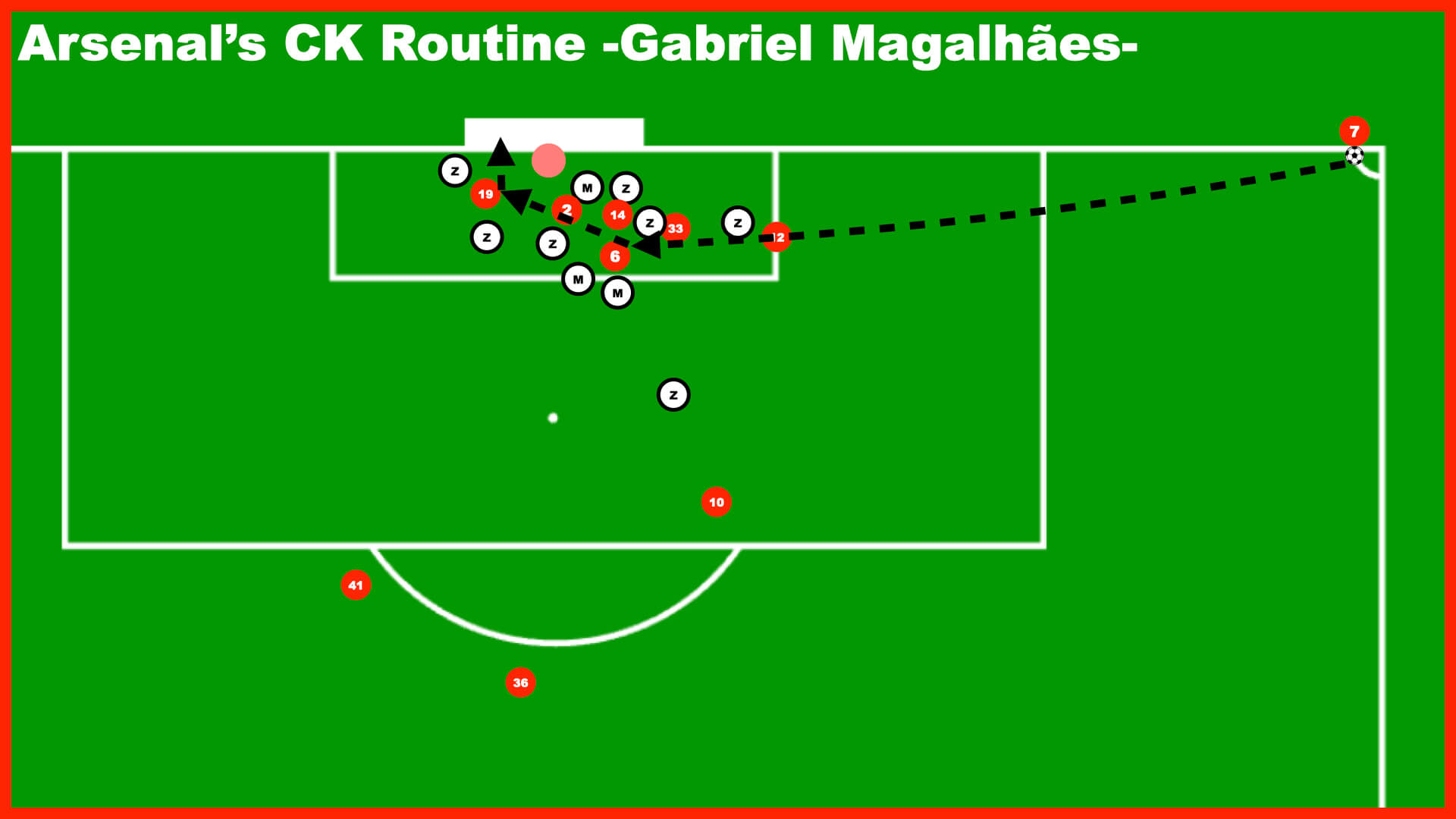
Against Atletico Madrid, he gave an assist by playing back the ball delivered towards the far side to find Gyökeres in front of the goal.
Saliba blocked the opposition goalkeeper and other three attackers at the far post made runs towards the first post to leave space for Gabriel.

Then, Gabriel drifted to the far side, but there was one more trick here.
Martinelli positioned himself close to Gabriel and seemed to have done nothing, but Gabriel ran past him to use him as a screen. Thanks to Martinelli, Gabriel’s marker was forced to move away from him, which created separation to give Gabriel more space.
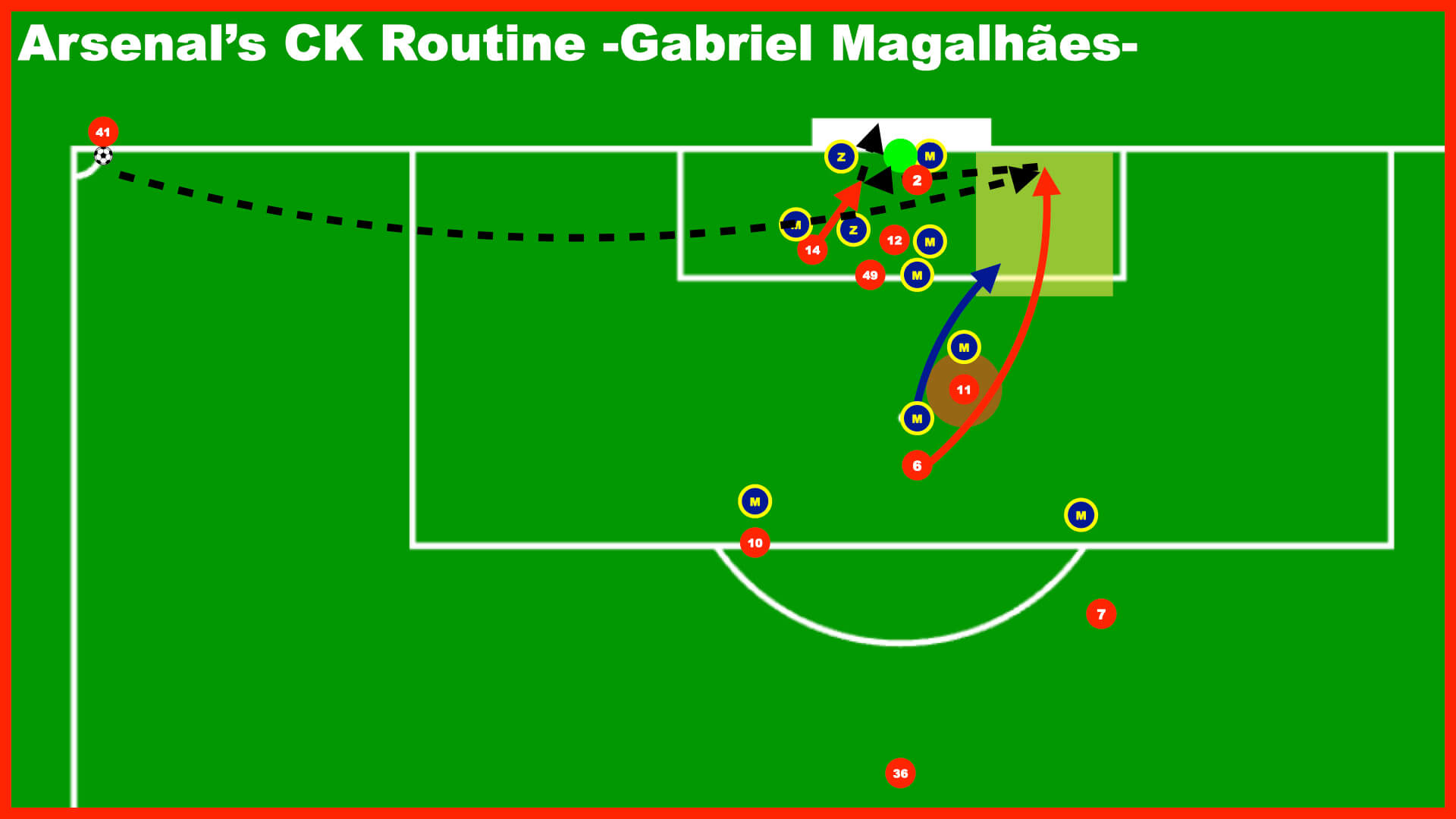
Then, Gyökeres, who initially made a run from the far side to the near side, turned his body and got ready to receive the ball from Gabriel. This quick reaction can tell us that they are prepared for even the second action in the routine.
Short Corners
Not only delivering crosses from the corners, but also Nicolas Jover designed some routines of short corners on several occasions, and there are mainly two types, one is mainly against zonal defensive setups and the other is mainly against man-oriented defensive setups.
When they played against Fulham, Burnley or Sunderland, who defended the corners with the zonal structure, Jover instructed Trossard (or Timber against Sunderland) to run along the goal line.

Three things to see here. Firstly, with Trossard coming short to Rice and Eberechi Eze (No.10) offering the passing option, they could create a 3v2 overload at the edge of the box. Secondly, as they knew to play short, Saliba dropped back straight to their own half just in case when they lost the ball there and conceded the opposition counterattack. He is mainly a blocker, so when they play short, he doesn’t have a role inside the box, although he could be a threat in the air (when Mosquera is there, he stays there). Finally, as soon as they played short, other attackers inside the box moved away to the far side to prepare for a cross towards the back post area.
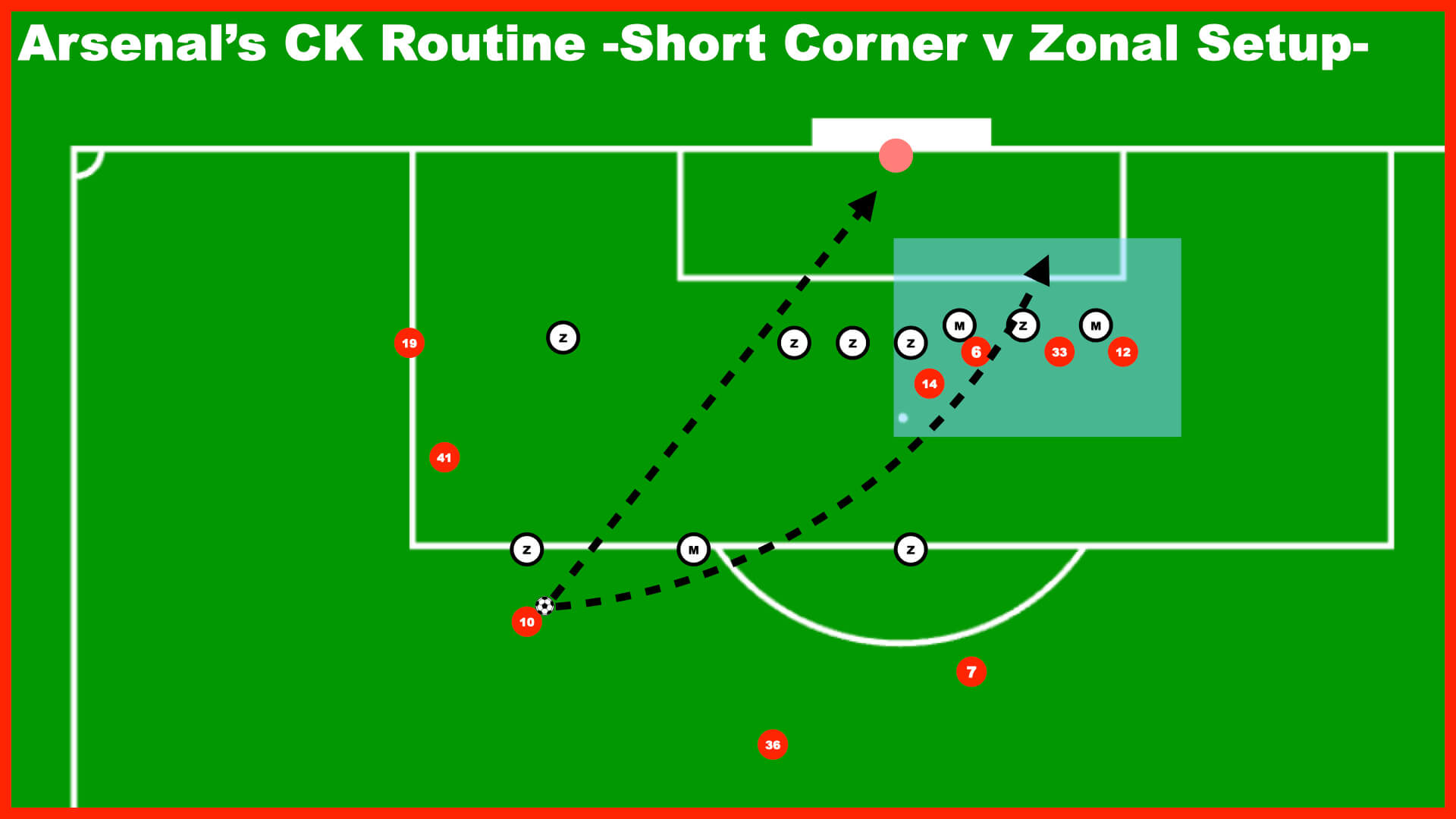
Eventually, Eze decided to take a shot and it was blocked, but if he could have successfully delivered a cross to the back post, all the attackers would have been ready for it.
Another routine is designed for mainly man marking setups. Unlike the previous one, Jover instructs someone at the edge of the box to make the first run. Here’s the example against Athletic Club.
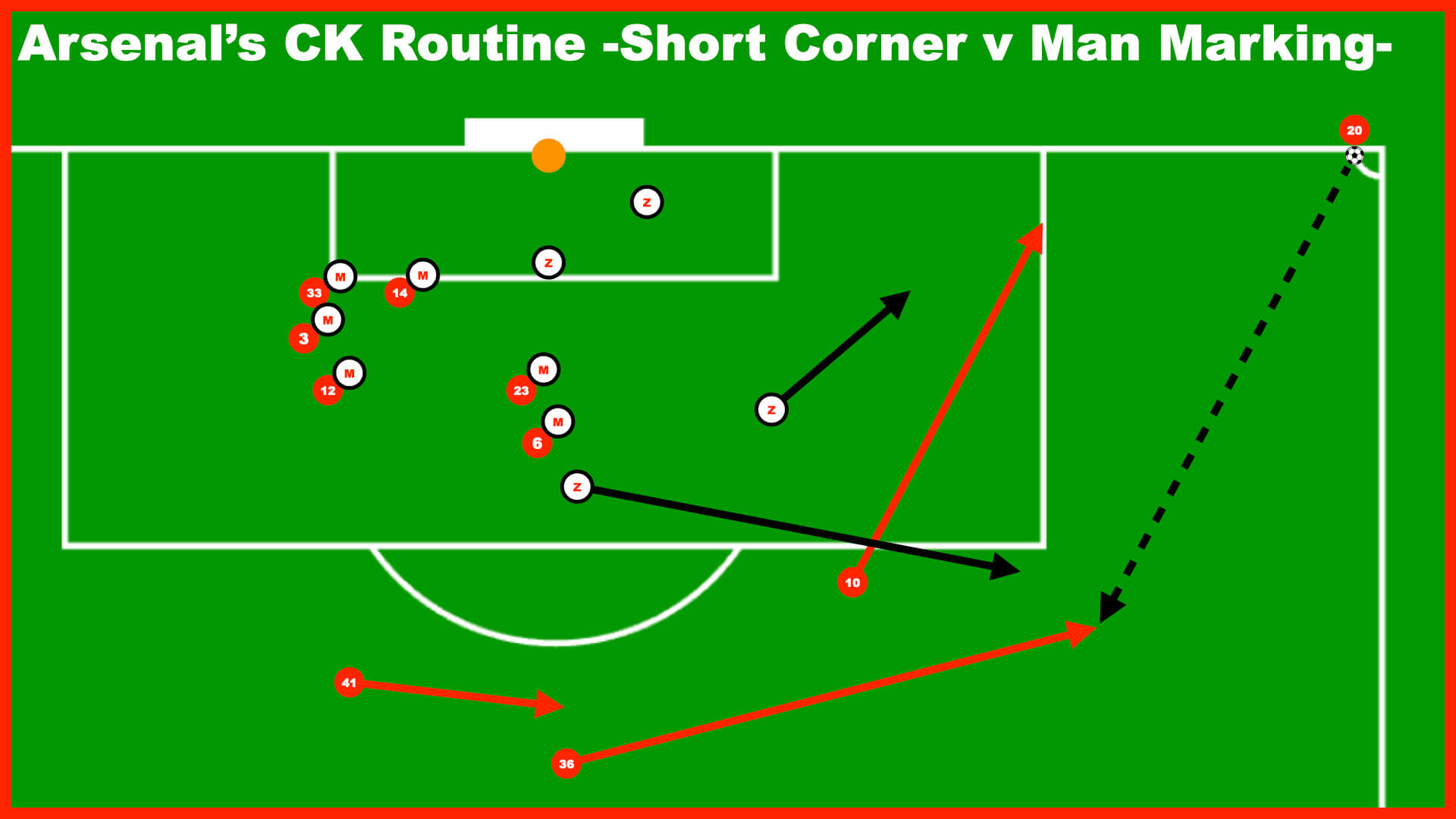
Eze made the diagonal run to the goal line, but this was a decoy. Zubimendi and Rice also moved across towards the ball side and Zubimendi received the ball from Noni Madueke (No.20). After this, the ball was played back to him and it looked like this.

This time, Madueke delivered a cross into the box, targeting at Mosquera. From this type of routine, Arsenal managed to equalise the game against Newcastle in the 84th minute.
Another possible option is to exploit the 3v2 overload around the ball. Eze, who made the initial run, was also ready to receive the pass inside the box. Arsenal sometimes utilise this option to try to get closer to the opposition goal.
These short corners can be played against specific opponents, and Jover has actually instructed them to play short on their first corner kick in each half or their first corner specifically from the right, such as against Burnley or Fulham.
Conclusion
Arsenal have detail and specific routines, so it is easy to analyse, but it is difficult to defend against them because of their individual superiority, variety and preparation.
Even though there are two man marking defenders against Gabriel, he can easily beat them and head the ball strongly. And, of course, they have great takers who can deliver the ball accurately to the target attackers.
From the same starting position, they can attack both near and far side, so it is difficult to predict. However, Arsenal players know where to attack, so the delivery and the players are always there. In addition to this, they have an option to play short, and it is also various as from the same runs they can deliver a cross, take a shot or penetrate into the box.
I believe this article has a lot of information, but this is only the analysis of corner kicks. They have more detail in free kicks and long throws. I hope you enjoyed this article, thank you for reading.


